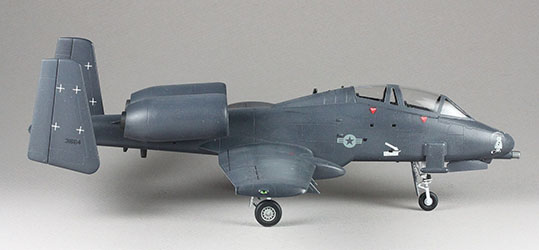
Hobby Boss 1/72 Night/Adverse Weather A-10 Thunderbolt II Build Review
By Chuck Holte
| Date of Review | September 2016 | Manufacturer | Hobby Boss |
|---|---|---|---|
| Subject | Night/Adverse Weather A-10 Thunderbolt II | Scale | 1/72 |
| Kit Number | 80267 | Primary Media | Styrene |
| Pros | Easy assembly, good detail | Cons | Cockpit/canopy shape/size issues, lacks underwing sensors |
| Skill Level | Basic | MSRP (USD) | $32.99 |
Background
The A-10A, single-seat, fixed wing, twin-engine, sub-sonic jet aircraft was developed in the late 1960s and early '70s for the USAF close air support (CAS) and ground attack (GA) missions. Designed as a 'Tank Killer,' it was later assigned a secondary mission, Forward Air Control – Airborne (FAC-A), and re-designated as the OA-10A. First flown in 1972 and accepted in service in 1977, the A-10A 'Warthog,' or more commonly 'Hawg,' was built around the 30mm GAU-8 'Avenger' rotary canon, its primary weapon, and 11 underwing hard points for munitions, countermeasures and sensors. Fairchild Republic produced 715 A-10As between 1972 and 1984.
The aircraft modeled in this review is the only two-seat Hawg. The first prototype A-10A, #73-1664, was converted to the family model configuration to add a Weapons Systems Officer position and to test and evaluate pod-mounted radar, forward looking infrared and low-light TV sensors. The two vertical tail fins were also extended upward for additional stability. Officially, '1664' was redesignated as a YA-10B, and may be seen on static display at Edwards AFB, CA.
Build Review
The Hobby Boss kit of the two seat Hawg is an easy build of an unusual aircraft. I found the parts fit excellent and obviously engineered for success. The one-piece lower fuselage, lower wing and horizontal stabilizers provide a solid base to get everything aligned and true. Likewise, the upper fuselage is in one piece and easily fits with it's counterpart, almost like a snap-tite, only a much better fit. The cockpit is adequate with six parts, including the two ejection seats and color decals for the instrument panels and consoles.
The canopy is molded in one piece, so opening the clamshells will require some surgery. I chose to leave mine closed. I've read that both canopy shells, fore and aft, were cut from the same mold on the real aircraft. On the model, the forward canopy is considerably wider than the aft, as is the cockpit. Without rebuilding the entire cockpit and casting a new canopy and windscreen, I don't see an easy way to fix this. I decided I could live with it with a closed canopy. Be sure to add nose weight before closing the fuselage – this is a tail heavy hawg. 

I liked the way the podded engines were designed and went together with the fuselage. Most of the seams were out of sight and the rest fit well. The engine's front compressor face is well done and when painted looks very realistic. The kit provided gun muzzle needed help – I drilled out the individual barrels and cooling holes with a small drill. With a little dark wash the gun and engine faces look good.
Construction was pretty much out of the box and very little seem work was needed. Surface detail was adequate. Weapons pylons were separate items and looked OK with molded on sway braces. Other than the pylons and the Pave Penny pod, there were no weapons or sensors. There are few photos of 1664 carrying weapons during the test phase, but many show the forward looking IR pod on the centerline and the large Westinghouse WX-50 Radar Pod hanging from the #4 pylon just inboard from the port gear landing gear bay. I'm disappointed that the kit didn't include these pods along with a more realistic Pave Penny; after all, they were key sensors for the N/AW tests. In any case, I wanted to show at least representative shapes and capabilities for the sensor pods, so I robbed the spares box.
Paint was Tamiya rattle can Gunship Gray lacquer, weathered slightly (after decaling) with Model Master Gunship Enamel thinned and lightened with flat white enamel. The decals were in register and went down like paint. Markings were for the early test flights and included the star-like calibration marks for the inside and outside of the vertical stabs and the N/AW Owl with an umbrella for both sides of the nose.
Conclusion
I found the Hobby Boss two-seat Warthog easy to build and finish. With the addition of appropriate underwing sensors, it looks the part, the tall tailed two-seat prototype that demonstrated a mission capability that would eventually go to the two-seat F-15E Strike Eagle.















